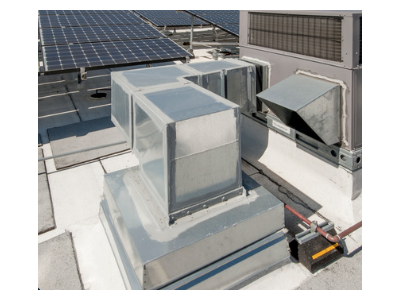
The key differences between a heat pump and traditional HVAC unit in commercial buildings..
Heat pumps and traditional heating systems serve the same purpose in commercial buildings: maintaining a comfortable indoor climate. However, they operate differently and have distinct features:
Heat Pump Unit
1. Operation: Heat pumps use electricity to transfer heat from a cooler space to a warmer space, making the cool space cooler and the warm space warmer. During the winter, they extract heat from the outside air or ground (even when it's cold outside) and transfer it inside. In the summer, they can reverse the process, acting like an air conditioner by removing heat from the building.
2. Efficiency: Heat pumps are known for their energy efficiency, especially in mild climates. They can provide up to three times more heat energy to a building than the electrical energy they consume because they move heat rather than generate it by burning fuel.
3. Types: There are several types of heat pumps, including air-source, water-source, and ground-source (geothermal), each with different installation considerations and efficiencies.
4. Cost and Installation: The initial installation cost of a heat pump, especially ground-source, can be higher than traditional systems, but they may offer lower operational costs due to their high efficiency, particularly in moderate climate zones.
Traditional Heating System (like Furnaces and Boilers)
1. Operation: Traditional heating systems generate heat by burning fuel (like natural gas, oil, or coal) or using electricity to heat an element. Furnaces heat air and distribute it through the building using ducts. Boilers heat water and distribute it as steam or hot water through pipes to radiators or underfloor heating systems.
2. Efficiency: Traditional systems typically have a range of efficiencies. Modern systems can be highly efficient, but generally, they are less efficient than heat pumps because generating heat inherently involves more energy loss.
3. Climate Suitability: Traditional heating systems are effective in a wide range of climates, including very cold areas where heat pumps (especially air-source) might be less efficient or require a supplemental heating system.
4. Cost and Installation: The initial installation cost of traditional heating systems can be lower than heat pumps, particularly for simpler systems like furnaces. However, the operational costs can be higher, especially where fuel costs are high or in inefficient systems.
Key Differences
- Efficiency: Heat pumps are generally more energy-efficient compared to traditional heating systems, particularly in moderate climates.
- Functionality: Heat pumps can provide both heating and cooling, whereas traditional heating systems only provide heat.
- Fuel Source: Traditional heating systems often rely on combustion of fossil fuels, whereas heat pumps typically use electricity.
- Environmental Impact: Heat pumps have a lower environmental impact, especially when powered by renewable energy sources, due to their high efficiency and because they don't burn fossil fuels.
- Climate Suitability: Traditional heating systems are often more effective in extremely cold climates, although modern heat pumps are improving and can include auxiliary heating for cold weather.
When choosing between a heat pump and a traditional heating system for a commercial building, consider factors like the local climate, energy costs, initial installation budget, space and infrastructure available, and long-term sustainability goals. Each system has its advantages and might be better suited to particular scenarios or preferences. Consulting with HVAC professionals can provide insights tailored to your specific building needs and local conditions.




